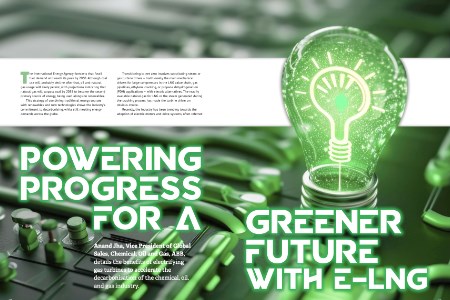[ad_1]
The International Energy Agency forecasts that fossil fuel demand will reach its peak by 2030. Although coal use will probably decline after that, oil and natural gas usage will likely persist, with projections indicating that natural gas will surpass coal by 2035 to become the second primary source of energy, being used alongside renewables.
This strategy of combining traditional energy sources with renewables and new technologies shows the industry’s commitment to decarbonising, while still meeting energy demands across the globe.
Transitioning to net zero involves substituting steam or gas turbine drives – traditionally the main mechanical drivers for large compressors in the LNG value chain, gas pipelines, ethylene cracking, or propane dehydrogenation (PDH) applications – with electric alternatives. The readily available natural gas for LNG or the steam generated during the cracking process has made the turbine driver an obvious choice.
Recently, the industry has been trending towards the adoption of electric motors and drive systems, often referred to as eTrains, for these applications. This shift away from traditional turbines is driven by initiatives focused on clean energy, efforts to decarbonise, and the goal of reducing greenhouse gas (GHG) emissions. These electric motor-drive systems are recognised for their high efficiency and contribution to more sustainable industrial operations.
The LNG value chain and electrification opportunity
Today, approximately 30% of the world’s energy needs are met by using gas. LNG is poised to play a significant role in the energy transition due to its ability to be transported over long distances. When liquefied, LNG takes up only 1/600th of the volume of natural gas in its gaseous state at atmospheric pressure, making it a highly efficient energy source for global distribution.
Nevertheless, the LNG value chain – encompassing extraction, processing, liquefaction, long-distance transport, and regasification as the gas moves from the wellhead to the consumer – can generate substantial GHG emissions, with potential outputs reaching 250 000 t of carbon dioxide equivalent (CO2-e). While various strategies, from managing methane emissions to carbon capture and offsets, exist to mitigate this impact, electrification stands out as a crucial factor in the push to decarbonise the LNG value chain.
The LNG value chain contains a range of large compressors with capacities varying from 1 – 75 MW. These compressors are prime candidates for electrification, where eTrains can be used as replacements for the mechanically driven gas turbines traditionally deployed to operate these substantial loads, particularly the main refrigeration (MR) compressors.
Comparing eTrains and gas turbines
Gas turbines have been commonplace in the LNG value chain, yet the adoption of eTrains is gradually rising. This shift is attributed to their superior operational flexibility and an established track record of high availability and reliability, coupled with reduced carbon emissions and costs.
Uninfluenced by temperature variations, eTrains maintain a consistent supply of power, crucial for maximising LNG production year-round. Flexibility in adjusting shaft speed allows the power output to precisely meet process demands, optimising compressor aerodynamics, and enabling a broader operational range. When it comes to thermal efficiency, eTrains integrated with combined cycle power generation can reach impressive efficiencies of 55 – 65%, substantially reducing fuel requirements and slashing GHG emissions. In contrast, gas turbines achieve only 30 – 40% thermal efficiency in simple cycle applications.
In operation, electric drives excel with their flexible, wide-ranging operability and fast start-up capabilities, ensuring less downtime and immediate reaction to varying process demands – benefits that contribute to a stable LNG production process. These systems can reach full operational load in under one minute and enable full pressure restarts without the need for refrigerant venting, compared to the slower, less responsive gas turbines which require warm-up periods and have torque limitations upon starting. The economic advantages of eTrains extend to significant reductions in both CAPEX and OPEX. They are associated with lower costs due to simpler infrastructure, reduced maintenance, and the elimination of the need for spare machinery parts that gas turbine systems often necessitate.
Moreover, eTrains can be monitored remotely and incorporate predictive maintenance to prevent failures. With limited mechanical components, process lifespans are extended, repairs are needed less frequently, and emissions are reduced.
The electrification revolution
An all-electric LNG study compared a 6.25 tpy LNG plant using a conventional gas turbine system with an all-electric drive configuration (e-LNG). The conventional system had six 30 MW gas turbine-driven trains in a 5+1 configuration, alongside two 30 MW electrical-power generation units. The e-LNG configuration was made up of four 40 MW trains powered by a 200 MW combined cycle power plant that was designed to capitalise on the efficiencies of electric drives. This design also has flexibility to take power from other sources like hydro or nuclear plants. Such a configuration could potentially save over 100 000 tpy of CO2 emissions.
This can be seen in action in ABB’s work at one of the American LNG plants. ABB delivered multiple electrical drive and motor systems for 18 modular e-LNG trains with a total nameplate capacity of 10 tpy. These trains were fabricated in less than two years after the project’s final investment decision was made. This is an immense step forward for LNG construction and showcases the advantages of electrical LNG technology.
Enjoyed what you’ve read so far? Read the full article and the rest of the June issue of LNG Industry by registering today for free!
Read the article online at: https://www.lngindustry.com/special-reports/27062024/powering-progress-for-a-greener-future-with-e-lng/
[ad_2]
Source link
